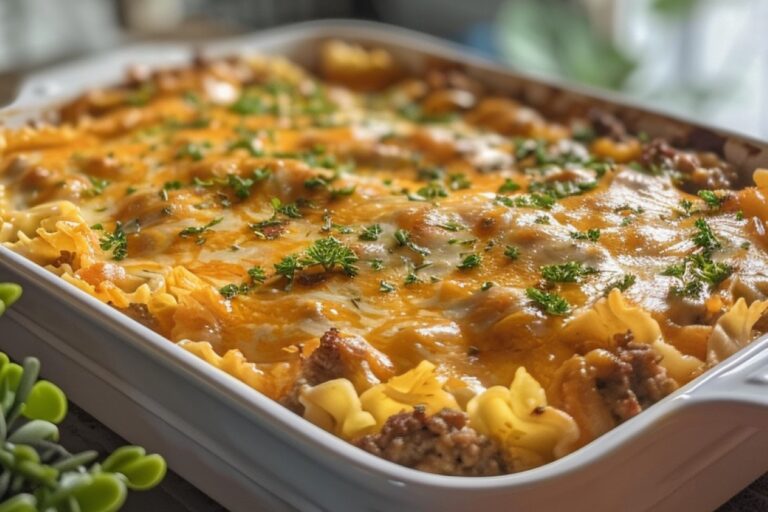In the bustling kitchens of today, hamburger casseroles emerge as the quintessential comfort food, perfect for both hectic weeknights and leisurely gatherings. But just how long is this delightful dish good for? Beyond its delicious taste, the shelf life of a hamburger casserole is crucial for maintaining both safety and quality. This comprehensive guide will explore not only the optimal storage times but also delve into the best practices for keeping your casserole tasting as fresh as the day it was made. From preparation to preservation, we cover all the bases, ensuring your casserole remains a reliable and enjoyable meal.
How Long is a Hamburger Casserole Good For?
When it comes to casserole storage, understanding the guidelines can make a world of difference. Whether you’re a meal prep enthusiast or simply looking to extend the life of your leftovers, knowing the hamburger casserole shelf life is essential.
Recipe Overview: The Foundation of Casserole Longevity
The longevity of your hamburger casserole starts with the recipe itself. A well-prepared casserole can not only satiate your hunger but also stand the test of time in your refrigerator or freezer.
- Servings: Typically serves 6
- Prep Time: 23 minutes
- Cook Time: 40 minutes
- Resting Time: 10 minutes after baking
- Total Time: About 1 hour 13 minutes
This robust dish combines savory ground beef, creamy sour cream, and a medley of cheeses, all layered between soft egg noodles. The ingredients not only blend for a mouthwatering meal but also contribute to how well the casserole holds up over time.
Equipment and Ingredients: A Closer Look
To ensure your casserole is prepped for longevity, you’ll need the right tools and ingredients:
- 13 x 9-inch casserole dish (lightly greased)
- Large skillet and pot for cooking noodles
- Main Ingredients: Ground beef, egg noodles, diced tomatoes, sour cream, and a trio of cheeses (Cheddar, Parmesan, and Mozzarella)
Each component plays a pivotal role in the casserole’s final texture and flavor, which in turn affects its storage potential.
Storage Tips: Keeping Your Casserole Fresh
After enjoying your meal, proper storage is key to extending the edibility of your casserole. Here’s how to keep it fresh:
- Refrigeration: Store in the refrigerator for up to 4 days. Be sure to cover the casserole dish with foil or transfer to an airtight container to prevent drying out.
- Freezing: For longer storage, freeze the casserole for up to 3 months. Wrap portions in aluminum foil or use freezer-safe containers to ward off freezer burn.
By adhering to these storage principles, you ensure that your hamburger casserole remains not just edible but also enjoyable for days or even months to come. For more inspiration on preparing family-friendly dishes, check out this hamburger casserole recipe that’s a family favorite. Now, let’s move on to the specifics of how temperature affects your casserole’s safety and quality.
Temperature Guidelines for Hamburger Casserole Storage
Understanding and maintaining the right temperature for storing your hamburger casserole is crucial to prevent foodborne illnesses and ensure optimal freshness. This section will discuss the specific temperature ranges to observe and provide a handy reference table for quick checks.

Importance of Temperature Control
Keeping your hamburger casserole at the right temperature from the moment it’s cooked to when it’s served again is key. The “Danger Zone” (40°F to 140°F) is where bacteria can grow most rapidly, and our goal is to minimize the time your casserole spends within this range.
Temperature Storage Table
Here’s a quick reference table to guide you on how to store your hamburger casserole at safe temperatures:
| Storage Method | Temperature Range | Duration |
|---|---|---|
| Refrigeration | Below 40°F (4.4°C) | Up to 4 days |
| Freezing | 0°F (-17.8°C) or colder | Up to 3 months |
| Reheating | Above 165°F (74°C) | Until hot throughout |
Tips for Effective Temperature Management
- Cooling Down: Allow the casserole to cool to room temperature within 2 hours before refrigerating or freezing. Splitting larger portions into smaller containers can accelerate cooling.
- Thawing and Reheating: Always thaw frozen casseroles in the refrigerator, not at room temperature. When reheating, ensure the internal temperature reaches at least 165°F to kill any potential bacteria.
By adhering to these temperature guidelines, you can safely enjoy your hamburger casserole with peace of mind, knowing it’s stored correctly. Next, we will explore how different storage methods affect the casserole’s taste and texture over time.
The Cultural Significance and History of Hamburger Casserole
Hamburger casserole, like many comfort foods, holds a special place in the culinary traditions of many families and regions. This section will delve into the origins of the hamburger casserole, exploring how it became a beloved dish in American homes and its variations across different cultures.
Origins of Hamburger Casserole
Hamburger casserole emerged as a popular dish during the mid-20th century, particularly in the United States, where convenience cooking became fashionable. The dish is a product of the post-war era, a time when families sought affordable, hearty meals that could feed multiple people and utilize readily available ingredients.
Evolution of the Dish
Over the decades, hamburger casserole has evolved. Initially, it was a simple dish made with ground beef, a starch like potatoes or noodles, and canned soup. Today, it embraces a variety of ingredients including different types of cheeses, spices, and fresh vegetables, reflecting the modern palate’s preference for more diverse flavors and healthier options.

Regional Variations
- Midwestern Influence: In the Midwest, hamburger casserole often includes a layer of corn or green beans, embodying the agricultural influence of the region.
- Southern Twists: In the Southern United States, variations might include spicy elements or biscuit toppings, incorporating local tastes and ingredients.
- International Takes: Around the world, adaptations of the hamburger casserole can be found, using local meats and spices that align with regional culinary traditions.
Cultural Impact
Hamburger casserole is more than just a meal; it’s a part of family gatherings, potlucks, and festive occasions. It represents comfort, convenience, and the blending of ingredients to create something that is greater than the sum of its parts. The dish has also been featured in cookbooks and cooking shows, further cementing its place in American culinary culture.
Modern-Day Relevance
Today, hamburger casserole remains a favorite for its ease of preparation and ability to be customized. It continues to adapt to contemporary dietary trends, making it a versatile dish suitable for various dietary needs.
Exploring the cultural significance and history of hamburger casserole not only adds depth to the article but also connects the reader to the rich tapestry of food history. This section will resonate with those interested in culinary heritage and the evolution of traditional dishes.




